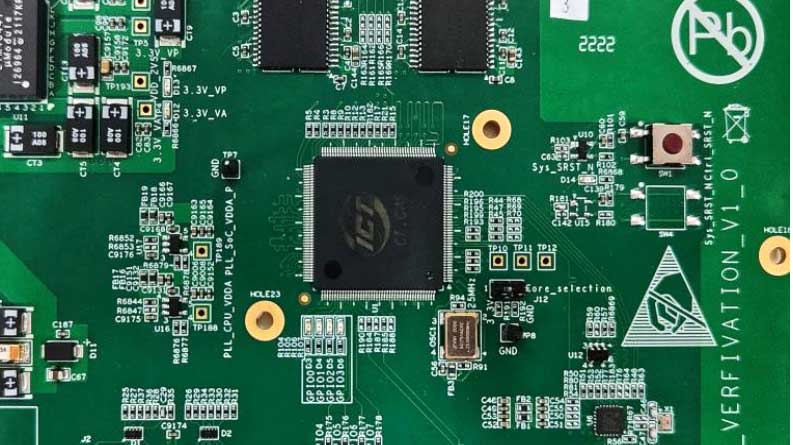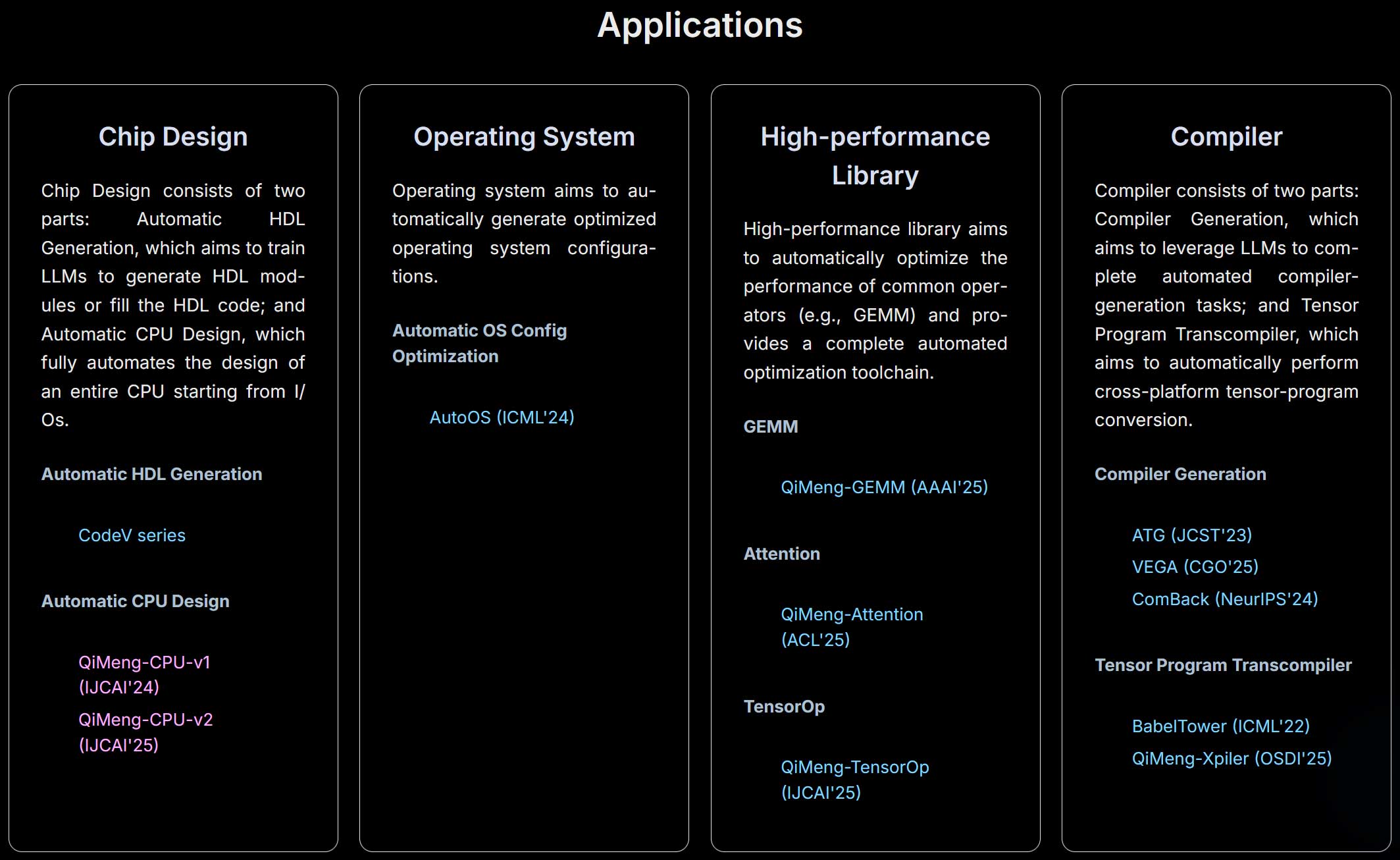China claims to have developed the world's first AI-designed processor — LLM turned performance requests into CPU architecture

China’s leading scientific institution has taken the wraps off QiMeng, an AI-powered system designed to accelerate chip design. The new open-source project from the Chinese Academy of Sciences (CAS) uses LLMs for “fully automated hardware and software design,” and can be used to design “entire CPUs.” But sample chips, so far, seem rather puny.
QiMeng means ‘enlightenment,’ according to an SCMP report on its unveiling. As of now, two processors have been created using QiMeng: QiMeng-CPU-v1, which is comparable to an Intel 486; and QiMeng-CPU-v2, which is claimed to rival an Arm Cortex A53. At the time of writing, CAS's link to the QiMeng-CPU-v2 project details is broken.

QiMeng-CPU-v1


Despite our snark about the first design being i486 (1989) level, there’s a significant advance from v1 to v2 if the newest sample reaches A53 (2012) capabilities. That’s a 23-year leap…
We have previously written about the latest innovations in AI chip design software from Western companies like Cadence and Synopsys. Both these big names in the EDA field have widely adopted AI. Cadence, for example, has delivered multiple AI platforms across the key steps of design and verification. Meanwhile, we know that Synopsys DSO.ai has assisted with over 200 taped-out chip designs, at the latest count.
However, the appeal of QiMeng, at least as far as we can tell from this early PR, is that it could be a bold industry disruptor with wider applications. The SCMP notes that this open-source effort has three key interconnected layers melding LLM chip design smarts, a hardware and software design agent, and various chip design apps. During tests, it is claimed that QiMeng can do in days what takes human teams weeks to achieve.
US sanctions force China innovation, again
QiMeng has come into view in the shadow of U.S. pressure on technology sanctions in general. However, it seems even more timely in the context of the more recent moves by the US Commerce Department with regard to export controls on software. Earlier this month, we reported that China tech giants like Lenovo and Xiaomi were reeling after Washington cracked down on software license availability from the likes of Cadence and Synopsys.
As noted by the CAS researchers, China must react, as chip design tech is “a strategically vital industry.” We await QiMeng-CPU-v3 with great interest, but aren’t expecting another 23-year leap in the technology stakes – that would be 2035 technology.
Get Tom's Hardware's best news and in-depth reviews, straight to your inbox.
Follow Tom's Hardware on Google News to get our up-to-date news, analysis, and reviews in your feeds. Make sure to click the Follow button.

Mark Tyson is a news editor at Tom's Hardware. He enjoys covering the full breadth of PC tech; from business and semiconductor design to products approaching the edge of reason.
-
bit_user Reply
The A53 is a 64-bit, 2-way, in-order pipelined core with split code & data caches, vector floating point, branch prediction, and branch target prefetching. If it has all of that, I'd be impressed. It also has page-table support, which is a key detail that distinguishes it from microcontrollers. I wonder if their core is microcontroller-tier or something capable of running a full-blown OS, like Linux.The article said:QiMeng-CPU-v2, which is claimed to rival an Arm Cortex A53
Given that the die shot shows only one core, I'm guessing it also lacks SMP support. That'd be another huge functional gap, if so, since it requires cache coherency support and atomics. -
Pierce2623 Reply
Why you gotta be realistic and ruin the hype?bit_user said:The A53 is a 64-bit, 2-way, in-order pipelined core with split code & data caches, vector floating point, branch prediction, and branch target prefetching. If it has all of that, I'd be impressed. It also has page-table support, which is a key detail that distinguishes it from microcontrollers. I wonder if their core is microcontroller-tier or something capable of running a full-blown OS, like Linux.
Given that the die shot shows only one core, I'm guessing it also lacks SMP support. That'd be another huge functional gap, if so, since it requires cache coherency support and atomics. -
Ktbpylon The fact that anyone keeps reading after the words "China claims" is baffling to me.Reply
Sincere question...are any of their technological creations ever tested or verified outside of China? -
heffeque Reply
Quite a few actually... there's plenty of BYD cars around the world, not only inside China (BYD already sells more cars around the world than Ford). Their 1 MW charger + battery tech does work as they say it works.Ktbpylon said:The fact that anyone keeps reading after the words "China claims" is baffling to me.
Sincere question...are any of their technological creations ever tested or verified outside of China?
CATL batteries are used by multiple car brands around the world, and are far superior, safer and better built than LG batteries (3rd largest battery manufacturer, after CATL and BYD).
Toyota is joining Huawei and Xiaomi to improve their tech.
Volkswagen is seeking Oppo's help to get more advanced 5G in their cars.
Europe's main 5G backbone used to be Huawei (before sanctions kicked in).
You must be one of those that think that China is still how it was in the 90s. -
nookoool ReplyKtbpylon said:The fact that anyone keeps reading after the words "China claims" is baffling to me.
Sincere question...are any of their technological creations ever tested or verified outside of China?
Because you are reading this in english which means it is 99% just a copy n paste from some other article by a guy sitting in some western country that can not speak / read chinese natively -
bit_user Reply
5G, batteries, and electric cars are all areas they've invested in for more than a decade. Those have nothing to do with this "AI-generated CPU". So, I agree with @Ktbpylon that we need to see some hard data on this thing.heffeque said:Quite a few actually... there's plenty of BYD cars around the world, not only inside China (BYD already sells more cars around the world than Ford). Their 1 MW charger + battery tech does work as they say it works.
CATL batteries are used by multiple car brands around the world, and are far superior, safer and better built than LG batteries (3rd largest battery manufacturer, after CATL and BYD).
Toyota is joining Huawei and Xiaomi to improve their tech.
Volkswagen is seeking Oppo's help to get more advanced 5G in their cars.
Europe's main 5G backbone used to be Huawei (before sanctions kicked in).
You must be one of those that think that China is still how it was in the 90s.
In contrast to your examples, we have only to look at how far short Moore Threads' S80 fell of its promises. That is also a much more relevant example than yours. -
bit_user Reply
Google translate is pretty good, in my experience - it will even translate text in images! If they published any meaningful details about this thing, I'll bet they would be clear enough, when reading an automatically-translated version of it. At least, that was my experience, last time I used it to read about a Chinese CPU.nookoool said:Because you are reading this in english which means it is 99% just a copy n paste from some other article by a guy sitting in some western country that can not speak / read chinese natively -
jp7189 AI is trained on existing data and cortex core plans are readily available. The fact that this can regurgitate something as complex as an A53 core is a testament to the training and inferencing techniques, but i don't believe this says anything about the ability to innovate something novel.Reply -
bit_user Reply
They're readily available, if you're a business and have the money to by an ARM Technology License. However, any CPU designed by an AI trained on that IP could potentially be considered a derivative work. I think ARM wouldn't knowingly give someone a Technology License, if they knew their IP would be used in this way.jp7189 said:AI is trained on existing data and cortex core plans are readily available.
We don't know that it actually did. What they said was that it's as fast as one. That could mean a lot of things, but it's almost certainly not as complex as one.jp7189 said:The fact that this can regurgitate something as complex as an A53 core -
jmills1981 Replybit_user said:However, any CPU designed by an AI trained on that IP could potentially be considered a derivative work.
Meanwhile PROPRIETARY code designed by AI trained off gpl licensed code gets a pass because of the "eew gpl eew opensource" false narrative.